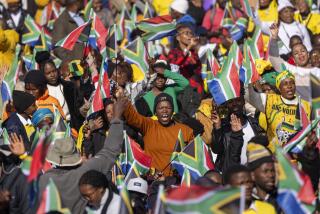ANC’s Heritage--Nonviolence to Guerrilla Attacks : Tactics: The anti-apartheid group is under pressure to negotiate. But many young members are impatient.
- Share via
CAPE TOWN, South Africa — The African National Congress, unbanned by the South African government Friday, is the oldest liberation movement in Africa and has spent the past 30 years as an outlaw guerrilla organization dedicated to overthrowing white minority-led rule.
Its armed campaign, waged by about 10,000 guerrillas in the military wing known as Umkhonto we Sizwe, or Spear of the Nation, has over the past three decades planted explosives in everything from army barracks to train stations, killing dozens and causing millions of dollars in damage.
But in recent years the ANC has been rocked by internal ideological debates centering on its guerrilla war. Two years ago, a new generation of young activists led the bombing campaign into white suburbs, killing civilians in shopping malls and on city streets. In 1988, a car bomb exploded as fans left a rugby match in Johannesburg, killing three whites.
President Oliver Tambo put an end to bombing so-called “soft targets,” and the guerrilla campaign has eased considerably in recent months. But Tambo recently suffered a stroke, and the ANC has been caught off guard by the rapid reform moves of President Frederik W. de Klerk, who has released former ANC general secretary Walter Sisulu and says he will soon free 71-year-old ANC leader Nelson R. Mandela as well.
The ANC also has come under mounting pressure to negotiate with Pretoria since the United States and the Soviet Union agreed to seek negotiated settlements to regional conflicts. And the organization is divided over how to respond to the changes in South Africa and what role Mandela, whom some ANC activists consider too moderate, should play once he is free.
“It’s not easy for us to sit down and negotiate,” Sisulu, 77, told the Weekly Mail in Johannesburg recently. “The problem is that many of the ‘youngers’ are not really interested in negotiations. In fact, they’ve become a little bit angry. We need time to educate our people.”
The ANC has undergone radical changes since it was launched in 1912 as the South African Native National Congress, a small group led by traditional chiefs. In the early years, it was primarily a pressure group promoting the interests of Africans by using legal means, such as sending petitions to the government and distributing leaflets.
The ANC began to resemble a mass liberation movement in the 1940s, when it adopted a constitution calling for universal suffrage. A Youth League was formed in 1943, drawing more radical blacks such as Mandela and Sisulu to the movement, and the young activists took control of the ANC in 1949.
One of its most successful protests was the “defiance campaign,” launched in 1952 against the sweeping apartheid legislation ushered in with the National Party victory in 1948. Thousands of blacks were arrested during the campaign for defying their pass restrictions and demanding service at whites-only counters in government buildings.
The mass campaigns of the 1950s were based on the principle of nonviolent resistance, for which Chief Albert Luthuli, the ANC president at the time, received the Nobel Peace Prize in 1960.
In 1955, the ANC adopted the “Freedom Charter,” which remains its guiding document today. The charter demands, among other things, equal rights for all South Africans, an equitable distribution of land and establishment of a democracy without regard to race.
Fierce debates over the charter led to a split in 1958, and Robert Sobukwe led a walkout and formed the Pan-Africanist Congress, one of the guerrilla groups De Klerk unbanned Friday.
The ANC and PAC were declared “unlawful organizations” in 1960, a month after police opened fire on blacks protesting pass laws in Sharpeville, killing 69 people.
Mandela and Tambo, law partners in Johannesburg, went underground in the late 1950s. In 1961, they and other ANC leaders formed the military wing of the ANC and began planning acts of sabotage against government installations.
The military wing’s high command was effectively destroyed in 1963 when police captured most of the leaders and, after a celebrated treason trial, sentenced them to life in prison. Tambo and many others fled into exile.
“I do not deny that I planned sabotage,” Mandela testified during the 1964 trial. “I did not plan it in a spirit of recklessness, nor because I have any love of violence. I planned it as a result of a calm and sober assessment of the political situation that had arisen after many years of tyranny, exploitation and oppression of my people by the whites.”
The ANC re-emerged as a powerful force in the late 1970s following the Soweto uprising, when thousands of young blacks left the country and joined the movement at its exile headquarters in Lusaka, Zambia. The government began an intensive campaign to snuff out the ANC. Death sentences were meted out for guerrillas captured inside South Africa, and ANC activists outside the country became the target of assassinations.
Today, the ANC has cultural, political and religious departments in addition to its military operations, and it has diplomatic offices in the United States and seven other countries. It operates a vast school for exiles in rural Tanzania and, supported by funds from dozens of sympathetic governments and organizations, it sends its members to colleges throughout the world. The military wing is primarily supported by the Soviet Union.
It remains closely aligned with the South African Communist Party, also unbanned by De Klerk on Friday, and many members of the ANC’s national executive board are Communists.
More to Read
Sign up for Essential California
The most important California stories and recommendations in your inbox every morning.
You may occasionally receive promotional content from the Los Angeles Times.














